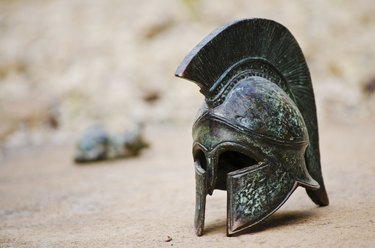
The Olympics were first officially inaugurated in Greece in 776 B.C. While there were a limited number of sports, athletes participated in a variety of training methods, from simply practicing their sport, to the legendary Milo of Croton lifting a calf overhead every day until it became a full-grown bull. While actual records of their training are somewhat limited, researchers have some knowledge of how these early Greek athletes trained.
Training
Video of the Day
Athletes generally trained in a specific gymnasium for their sport called a xystos, where they were frequently coached by former champions. The vast majority of their training consisted of practicing the skills of their sport. In boxing and wrestling, neither of which featured weight classes, much of the time was spent sparring and grappling. In pankration, a fighting contest in which only biting and eye gouging were prohibited, much time was spent sparring, but in a more gentle manner.
Video of the Day
Non-Specific Training
One of the ways athletes stayed in condition was through daily life. As everything was done by hand, the amount of physical work that was accomplished by an athlete in addition to his training generally served as an excellent off-season conditioning program. Many athletes who competed in various events such as any of the fighting contests, races including the chariot race, or the javelin throw, were active members of the military and much of their training was combative in nature. The hoplitodromos was a foot race in which the contests wore armor consisting of a helmet, greaves and a shield.
Training and Education
In the course of training, while an athlete would spend a great deal of time training the body, usually through bodyweight exercises and acrobatics, time was also spent training the mind. A palaestra, or ancient Greek wrestling school, in addition to rooms featuring equipment like heavy bags, also featured rooms for education where the youths were taught the Greek ideals as part of an all-around education. The concept of "mind, body and spirit" was not just a slogan to the ancient athletes, it was a way of life.
Additional Training
Any specific training that athletes wished needed to be performed on their own. Given the lack of full-time coaching and the need to work at home, many athletes simply ran for conditioning work or performed bodyweight exercises at home to supplement the work they often did as soldiers. The grueling amounts of physical labor over the course of the day that were required outstrip many conditioning programs in use today. Stonecutters were notorious for their physical strength and this served them well in grappling events. Messengers did better in the races. So even the ancient athletes understood the need for cross training as well as specific training, but little record remains of the specifics.